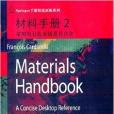《材料手冊2:常用的有色金屬及其合金》是2014年哈爾濱工業大學出版社出版的圖書,作者是卡達雷利。
基本介紹
- 中文名:材料手冊2:常用的有色金屬及其合金
- 作者:卡達雷利
- 出版社:哈爾濱工業大學出版社
- 出版時間:2014年4月1日
- 頁數:1340 頁
- 開本:16 開
- ISBN:9787560344485
- 外文名:Materials Handbook:a Concise Desktop Reference
- 語種:簡體中文, 英語

《材料手冊2:常用的有色金屬及其合金》是2014年哈爾濱工業大學出版社出版的圖書,作者是卡達雷利。
《材料手冊2:常用的有色金屬及其合金》是2014年哈爾濱工業大學出版社出版的圖書,作者是卡達雷利。1內容簡介獨特的和實際的材料手冊(第二版)提供快速和容易獲得的物理和化學性質上的數據所有類別的材料。該第二版已大大擴大包括...
《常用金屬材料手冊》是2007年6月化學工業出版社出版的一本書籍,作者是鄭峰。本書重點介紹常用金屬原料及其產品的牌號、化學成分、力學性能、特性與用途,以及常用金屬產品的品種、規格、尺寸、允許偏差和質量等。內容簡介 簡要介紹金屬材料...
《有色金屬材料手冊》是有色金屬材料及其套用方面的大型工具書。分篇介紹了鋁及鋁合金,鎂及鎂合金,銅及銅合金,鎳、鈷及其合金,鋅、鉛、錫及其合金,鈦及鈦合金,鎢、鉬及其合金,硬質合金,鉭、鈮及其合金材料,鈹、鋯、鉿及其...
在電廠設備中,有色金屬材料有著廣泛的套用。常用的有鋁及鋁合金、銅及銅合金、鈦及鈦合金等。鋁合金常用於製作熱交換器、管子、容器、売體及鉚釘等;銅合金更適合勇於製作一些耐腐蝕零件,如渦輪、軸瓦、軸套等;鈦合金在火電廠中更...
《新編有色金屬材料手冊(第2版)》是2016年機械工業出版社出版的圖書。 內容簡介 本手冊是一本根據現行相關國家標準和行業標準編寫而成的有色金屬材料工具書,其主要內容包括有色金屬材料基礎資料、鋁及鋁合金、鎂及鎂合金、銅及銅合金...
《實用有色金屬材料手冊》是2008年機械工業出版社出版的圖書,作者是曾正明。內容簡介 本手冊是一部標準最新、品種較全、內容殷實的實用型有色金屬材料工具書。全書共分15章,即:有色金屬材料的基本知識,銅及銅合金,鋁及鋁合金。鈦...
中性氯化物和酸性一氧化性氯化物能造成材料的腐蝕,常見的腐蝕形式為點蝕、縫隙腐蝕和應力腐蝕開裂。因康鎳合金 Inconel 600 Inconel 600合金是Ni-Cr系奧氏體耐熱合金,屬於美國因康鎳合金中的一種。由於較高的鉻含量,合金在高溫下...
《常用金屬材料手冊(第2版)(下)》是2007年中國標準出版社出版的圖書,作者是賈耀卿。內容簡介 《常用金屬材料手冊(第2版)(下)》包括:鑄造合金、銅、鋁、錫、鉛、鎳、鋅、鎂及其合金,稀有輕金屬、稀有高熔點金屬、貴金屬、...
《新編有色金屬材料手冊》是2010年7月機械工業出版社出版的圖書,作者孫玉福。本手冊的主要內容包括有色金屬材料相關知識,鋁及鋁合金,鎂及鎂合金,銅及銅合金,鋅及鋅合金,鈦及鈦合金,鎳及鎳合金,鉛、錫、銻及其合金,稀土金屬及...
1996年冶金工業出版社出版的圖書 《常用金屬材料手冊--有色金屬產品部分》是1996年冶金工業出版社出版的圖書,作者是趙世臣。 作者 趙世臣編 出版時間 1996年01月 出版社 冶金工業出版社 頁數 909 頁 ISBN 9787502417703 定價 95.00 裝...
其主要內容包括基本資料,生鐵、鑄鐵及鐵合金,常用鋼種,鋼管,鋼板及鋼帶,盤條及鋼筋,鋼棒、鋼絲及型鋼,銅及銅合金,鋁及鋁合金,鎂及鎂合金,其他常用非鐵金屬材料,金屬複合材料,共12章。圖書目錄 第1章 基礎資料 1.1法定計量...
本手冊分三大部分共二十六章,涵蓋了我國現行、常用金屬及其合金的品種和規格。主要內容分為基本知識、黑色金屬及其合金材料和有色金屬及其合金材料三部分。圖書目錄 第一部分 金屬及其合金材料基本知識 一、標準代號和常用數據 (一)技術...
本手冊共兩篇,分為二十二章,包括:黑色金屬材料基本知識,生鐵和鑄鐵件,鑄鋼,結構鋼、工具鋼及特殊鋼,型鋼,鋼板和鋼帶,鋼管,鋼絲,常用黑色金屬材料中外牌號對照,有色金屬材料的基本知識,銅及銅合金,鋁及鋁合金,鈦及鈦合金,...
1.2.3 變形鋁及鋁合金牌號表示方法 1.2.4 變形鋁及鋁合金狀態代號 1.2.5 貴金屬及其合金牌號表示方法 1.2.6 稀土產品牌號表示方法 1.2.7 半導體材料牌號表示方法 1.3 有色金屬及其合金常用術語 1.3.1 一般術語 1.3.2 ...
1.3.4鋅及鋅合金牌號表示方法26 1.3.5鈦及鈦合金牌號表示方法27 1.3.6鎳及鎳合金牌號表示方法28 1.3.7稀土金屬材料牌號表示方法28 1.3.8貴金屬及其合金牌號表示方法29 1.4金屬材料相關術語31 1.4.1常用金屬材料組織術語31 ...
第四節 金屬材料的表示方法 一、基本原則 二、常用鋼鐵產品的命名符號 三、常用鋼鐵產品的牌號表示方法 四、鋼鐵產品牌號統一數字代號體系(GB/Tl7616-1998)五、有色金屬及合金牌號表示方法 六、國際標準化組織(ISO)鋼號的表示方法 ...
這次修訂,又增加了輕、重鋼軌,砂型離心鑄鐵管和灰口鑄鐵管件,調整充實了鐵合金,工業鋁粉,有色金屬板材、帶材及管材等內容。本手冊以常用金屬材料的最新國家標準為基礎整理匯集而成,內容全面、豐富、新穎、實用,適用於工礦企業、基本...
1.常用元素對有色金屬材料性能的影響 2.常用元素對鑄鐵性能的影響 3.常用元素對鋼性能的影響 四、金屬材料的熱處理 五、金屬材料牌號表示方法 1.鋼鐵產品牌號表示方法 2.有色金屬產品牌號的表示方法 3.鑄造有色金屬及其合金牌號的表示...
2.變形鋁及鋁合金狀態代號的表示方法(GB/T 16475—2008)6 3.常用有色金屬及其合金產品牌號的表示方法13 4.常用有色金屬及其合金牌號的表示舉例17 三、有色金屬材料的性能19 1.常用有色金屬的主要特性19 2.常用有色金屬的熔點、...
常用的有色合金有鋁合金、銅合金、鎂合金、鎳合金、錫合金、鉭合金、鈦合金、鋅合金、鉬合金、鋯合金等。有色金屬中的銅是人類最早使用的金屬材料之一。現代有色金屬及其合金已成為機械製造業、建築業、電子工業、航空航天、核能利用等...
《有色金屬材料手冊(下)》是2009年7月化學工業出版社出版的圖書,作者是黃伯雲、李成功、石力開、邱冠周、左鐵鏞。內容簡介 《有色金屬材料手冊(下)》是有色金屬材料及其套用方面的大型工具書。分篇介紹了鋁及鋁合金,鎂及鎂合金,...
《有色金屬材料手冊(上)》是2009年化學工業出版社出版的圖書,作者是黃伯雲,李成功,石力開,邱冠周,左鐵鏞。內容介紹 《有色金屬材料手冊(上)》是有色金屬材料及其套用方面的大型工具書。分篇介紹了鋁及鋁合金,鎂及鎂合金,銅...
1.1.1鋼鐵材料(黑色金屬材料)的 分類 1.1.2有色金屬材料的分類 1.2金屬材料牌號的表示方法 1.2.1鋼鐵材料牌號的表示方法 1.2.2有色金屬及合金牌號的表示 方法 1.2.3鑄造有色金屬及其合金牌號的 表示方法 1.3國內外常用...
《金屬材料手冊》共兩篇,分為18章,內容包括:黑色金屬材料基本知識,生鐵和鑄鐵件,鑄鋼,結構鋼、工具鋼及特殊鋼,型鋼,鋼板和鋼帶,鋼管,鋼絲,常用黑色金屬材料中外牌號對照,有色金屬材料的基本知識,銅及銅合金,鋁及鋁合金,鈦...
《常用金屬材料牌號手冊》是2009年2月中國標準出版社出版的圖書,作者是 楊家斌。本書基本涵蓋了常用金屬材料的牌號,對廣大金屬材料從業者是很有用的工具書。內容簡介 本手冊採用資料新,依據最新的國家標準和行業標準350餘項,牌號新,...
本手冊匯集國內外最新資料,詳細介紹了常用金屬材料的牌號、化學成分、規格、性能、用途、尺寸、理論質量、熱處理規範以及中外牌號對照等數據。在第一版基礎上,更新了多個鋼號,增補了多個鋼種和鈦合金等有色金屬牌號,並新增了金屬材料速...
《常用建築金屬材料手冊》是2014年4月化學工業出版社出版的圖書,作者是郭強。內容簡介 本書詳細介紹了建築中常用的碳素結構鋼、合金結構鋼、不鏽鋼、鋁合金、銅合金的板材、型材、管材、線材等的力學性能、表面處理、產品使用方法和注意...
